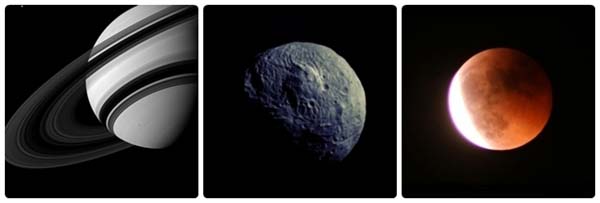Report
- Published: Saturday, March 30 2013 09:20

As a part of GAM 2013 AstroArt efforts, Nahum Chazarra will be presenting three of his video work:
- “8 Years Around Saturn” -- a video was created using the images taken by Cassini probe of the Saturnian system since 2004.
- “Dawn at Vesta: 8 Months in Orbit” -- the video summarizes 8 months of Dawn orbiting asteroid Vesta using the image sequences taken by Dawn in visible light and some 3D landscapes extracted from real images.
- “Total Lunar Eclipse 15 June 2011” -- the total lunar eclipse from Granada, Spain in 2011.
Video screen followed by Q&A session on 25 April, 20:00 - 20:30 UT at Cosmoquest.
"I never realized the power of the NASA image archives until I was searching for some full resolution images of Mars from the Viking missions. I was so incredibly amazed by all the imagery that was completely forgotten that I couldn't resist looking at every single image available. And that is how my first video was born, through searching all the sequences on the Cassini image archives and creating a motion video using the frames available for that: no interpolation, no effects, just the raw images because they had the power to communicate the beauty of our neighborhood. I mainly use two tools: Photoshop for the color grading and Premiere for editing the video. For my latest video using Dawn images, I created accurate 3D terrain models and texturized the original photographs to enhance the available images.”
“It's quite different when I work with my own images, because I can shoot as many as I want (weather permitting) and repeat every sequence until I'm happy with the result (although that’s the most difficult part). My tools are a Canon 550D, an 8" telescope, and a old compact camera."
###
Artist bio:
Nahum Chazarra has been fascinated with science since an early age. His parents bought him a telescope before he was 10 years old, and he enjoyed spending sunny days in the field collecting fossils. Currently, Chazarra is engaged in classes, research, and public talks on astronomy and planetary geology. He is a participant in the HiTranslate project, working to communicate current research on Martian geology to the Spanish-speaking public. He writes science popularization articles that have been published in the Journal of Feelsynapsis and Hablando de Ciencia, and owns two blogs – one about geology, and the other about planetary geology.
Chazarra’s latest work involves creating inspiring videos from space mission image archives, in an effort to demonstrate that science can be incredibly beautiful.








Comments